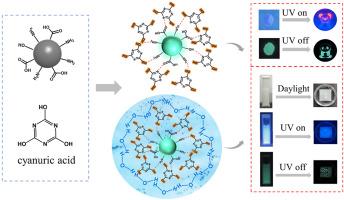Eco-friendly carbon dots exhibiting aqueous-stable room-temperature phosphorescence for anti-forgery and information hiding
IF 3.6
3区 物理与天体物理
Q2 OPTICS
引用次数: 0
Abstract
Carbon dots (CDs) with room-temperature phosphorescence (RTP) characteristics have drawn considerable attention because of their broad applications in various area. However, achieving water-soluble RTP CDs remains highly challenging owing to the severe phosphorescence quenching effect caused by dissolved oxygen in aqueous solutions. Herein, a realizable strategy of attaining long-lifetime and high stability RTP CDs-based composites in aqueous solutions is proposed via constructing a rigid hydrogen-bonded network. The synthesized composites display an ultra-long phosphorescence lifetime of 1.38 s in solid state and 316 ms in aqueous phase. Moreover, the RTP emission remains visible to naked eye for up to 10 s even under strongly acidic or alkaline conditions. TEM, XRD, FT-IR, and XPS analyses confirmed the successful conjugation of cyanuric acid (CA) with carbon dots (CDs) which the rigid CA framework effectively restricted the chromophore vibrations and rotations, minimizing non-radiative recombination of triplet excitons. Finally, applications of CDs in screen printing, anti-counterfeiting and information protection were explored.

具有水稳定室温磷光的环保碳点,具有防伪和信息隐藏功能
具有室温磷光特性的碳点因其在各个领域的广泛应用而受到广泛关注。然而,由于水溶液中溶解氧引起严重的磷光猝灭效应,实现水溶性RTP CDs仍然具有很高的挑战性。本文通过构建刚性氢键网络,提出了一种在水溶液中获得长寿命、高稳定性RTP cds基复合材料的可行策略。合成的复合材料显示出超长的磷光寿命,固态为1.38 s,水相为316 ms。此外,即使在强酸性或强碱性条件下,RTP发射仍可在10秒内肉眼可见。TEM, XRD, FT-IR和XPS分析证实了氰脲酸(CA)与碳点(CDs)的成功偶联,刚性的CA框架有效地限制了发色团的振动和旋转,最大限度地减少了三重态激子的非辐射重组。最后探讨了光盘在丝网印刷、防伪、信息保护等方面的应用。
本文章由计算机程序翻译,如有差异,请以英文原文为准。
求助全文
约1分钟内获得全文
求助全文
来源期刊

Journal of Luminescence
物理-光学
CiteScore
6.70
自引率
13.90%
发文量
850
审稿时长
3.8 months
期刊介绍:
The purpose of the Journal of Luminescence is to provide a means of communication between scientists in different disciplines who share a common interest in the electronic excited states of molecular, ionic and covalent systems, whether crystalline, amorphous, or liquid.
We invite original papers and reviews on such subjects as: exciton and polariton dynamics, dynamics of localized excited states, energy and charge transport in ordered and disordered systems, radiative and non-radiative recombination, relaxation processes, vibronic interactions in electronic excited states, photochemistry in condensed systems, excited state resonance, double resonance, spin dynamics, selective excitation spectroscopy, hole burning, coherent processes in excited states, (e.g. coherent optical transients, photon echoes, transient gratings), multiphoton processes, optical bistability, photochromism, and new techniques for the study of excited states. This list is not intended to be exhaustive. Papers in the traditional areas of optical spectroscopy (absorption, MCD, luminescence, Raman scattering) are welcome. Papers on applications (phosphors, scintillators, electro- and cathodo-luminescence, radiography, bioimaging, solar energy, energy conversion, etc.) are also welcome if they present results of scientific, rather than only technological interest. However, papers containing purely theoretical results, not related to phenomena in the excited states, as well as papers using luminescence spectroscopy to perform routine analytical chemistry or biochemistry procedures, are outside the scope of the journal. Some exceptions will be possible at the discretion of the editors.
 求助内容:
求助内容: 应助结果提醒方式:
应助结果提醒方式:


